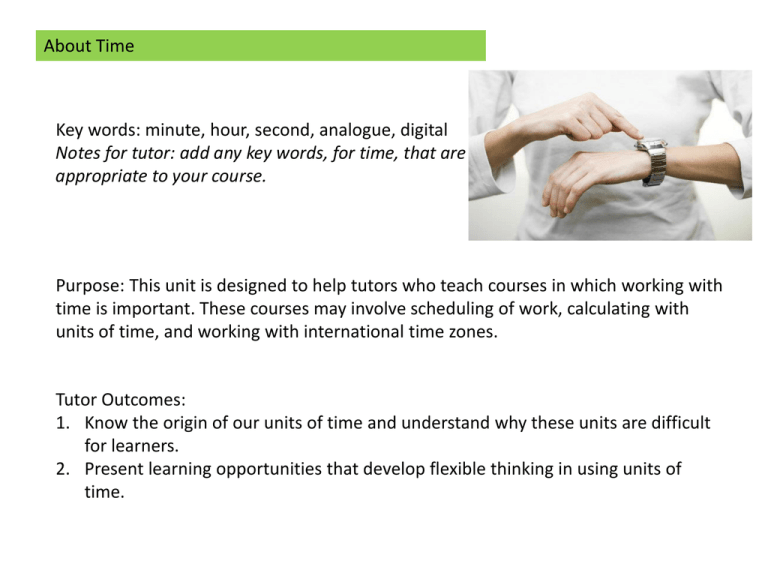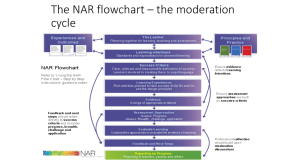Time unit - National Centre of Literacy and Numeracy for Adults
advertisement

About Time Key words: minute, hour, second, analogue, digital Notes for tutor: add any key words, for time, that are appropriate to your course. Purpose: This unit is designed to help tutors who teach courses in which working with time is important. These courses may involve scheduling of work, calculating with units of time, and working with international time zones. Tutor Outcomes: 1. Know the origin of our units of time and understand why these units are difficult for learners. 2. Present learning opportunities that develop flexible thinking in using units of time. Section 1: Mathematical Background Page 1: Where did the units of time come from? The units of time we use for seconds, minutes and hours came from ancient Babylonia (present day Iraq). The Babylonian year was 360 days made up of 6 months of 60 days. It is not clear why 60 was so popular but it may be that it can be divided easily into many fractions, e.g. ¼ of 60 is 15. So that is why there are 60 seconds in a minute and 60 minutes in an hour. There are 24 hours in a day and 24 can be fractioned easily as well! Section 1: Mathematical Background Page 2: Why do learners find time challenging? There are two reasons why measuring time is challenging. The first reason is that: Unlike length, area, and volume it is not physically tangible. Unlike weight and temperature we cannot trust our senses to measure it. Like normal air pressure, time is with us all the time so we need to make a deliberate effort to notice it. Unlike air pressure, we have no way to speed it up or slow it down (apologies to Einstein). Time is tied to emotion and perception. Events we do not like seem to take a long time. Events we like are over way too soon. Three minutes of pain seems much longer than three minutes of holiday. Section 1: Mathematical Background Page 3: The second reason is that Time is difficult because many of the standard units we choose to measure it with are based on 12, 24, 60 or 360. This makes it difficult to add and subtract time using our base ten number system. For example, suppose a job starts at 10:40am. It is “forty minutes past ten in the morning” or “twenty to eleven in the morning.” The job lasts an hour and a half. When will it be finished? Firstly you need to recognise that one and a half hours is one and a half lots of 60 minutes since there are 60 minutes in an hour. 1½ x 60 = 90 minutes. Then, you have to add on 90 minutes because you are working with 60 not 100. + 20 10:40am + 60 11:00am + 10 12:00pm 12:10pm Section 2: Activity Page 1: Time and language Brainstorm: Whole class. Ask learners to think of anything to do with time. May include proverbs and sayings, and the different ways we record time. Tutor to record. ( recognising prior knowledge, acknowledges the impact of culture and work life on how we operate with time and how we think about time). Discuss responses focusing on the ones that are appropriate for your course .e.g egg timer for hospitality, 24 hour clock for tourism. Examples: Hours, minutes, seconds, digital, analogue, 24 hour, days, months, years etc. ‘Time and tide waits for no man’. ‘All in good time’. ‘Times up’. Half time, full time, part time For the time being Lets call it a day No time like the present Section 2: Activity Page 2: What aspects of time do your learners need to know about and be able to use in their course? Ask learners to discuss and record in pairs, then report back. Tutor to record. ( recognising prior knowledge). If students do not think of things to do with time management in general or anything else that you think is relevant, prompt them. Discuss things like: •Hours, minutes, seconds, am, pm. •Specific language of time used in the course. E.g. Part time, full time, time in lieu. •Specific recording of time. E.g 24 hour clock •Specific calculations for time. E.g. truck drivers allowing for rest times •General time applications. E.g time management Section 2: Activity Page 3: Building 60 Jigsaw: Provide each learner with the pieces from the two circles and two strips, marked in sections (Copy master 1) The tutor to have the pieces already cut and in sets. Pose the following problems: •Using the circle pieces make a clock showing 60 minutes. •Ask learners to share with a partner what they did and why it makes 60 minutes. •Ask learners to replicate this with the strips. Discuss: why do the circle and the strip show the same amount of time? In pairs use the circle pieces and then the strip pieces (or the other way around) ask questions such as: •What would two hours look like? •What would one and a half hours look like? •How many fifteen minutes in an hour? •How many five minutes in an hour? •Which is bigger three lots of 15 minutes or 45 minutes? Section 2: Activity Page 4: What about am and pm? Discuss the meaning of am and pm. (a is before p in the alphabet therefore am is the morning, anything that you know that will help the learner remember which is morning and which is afternoon) Provide the learners with 2 strips of paper. Pose the following problems: •Mark the hours 1 – 12 on each strip. Why 1-12? Discuss. •Label one strip am and the other pm. Fold to show in analogue. Discuss. •Put the moon at the top and the sun at the bottom of the am strip. (Copy Master 2 is an example). •Put the second strip below the first one to show 24 hours and how am and pm link. Place them in a circle to show a 24 hour day going from midnight to midday and back to midnight. •Mark on lunch time, morning tea, when you get up and other times relevant to the learners. •Record these times in different formats. E.g 1 o’clock, 1.00am, 1300. Discuss Section 2: Activity Page 5: 24 hours – going over midnight •Tutor to write a time on the board. E.g 6am •Learners in pairs discuss other ways of recording this time (analogue, digital, 24 hour) •Share and discuss as whole group •Tutor asks learners, ‘what happens when you go over midnight?’ •Discuss •Learners in pairs •Each learner writes a time. Learners swap and fill in as many other ways of recording the time given. • Discuss answers. Section 2: Activity Page 6: Reading time in different formats Provide learners with different time formats. Learners in pairs: •Find 6 o’clock on each format. Ask why? Share and discuss. •Find 1400 hours on each format. Ask why? Share and discuss. •Find 2pm on each format. Ask why? Share and discuss. Provide learners with copies of time formats specifically used in their course. Ask similar problems relevant to these time formats Examples: time sheets, log books, cleaner sign offs, travel times, bus timetables, nursing charts. Bookings for appointment Section 2: Activity Page 7: What time is it? Recording time: Time is set out in different formats. Provide each pair of learners with copy master 3. Ask them to record the times marked on each diagram. Tutor: Select one or two of the diagrams and ask for feedback from the learners. Discuss. Points arising could be: •The numbers used in a 24 hour format and what they mean. •Am and pm •Hours in a day, minutes in an hour and seconds in a minute. •The appropriate way to record time in different situations – when would you use digital or analogue or 24 hour. Repeat this activity using time formats specifically used in your course. Section 2: Activity Page 8: What time is it? Calculating time using a number line. Example 1: Refer to slide 4 for adding on time. Example 2: Working out the difference You started work at 8:30 or half past eight. You finished the job at 10:45 or quarter to eleven. How long did the job take? Learners need to recognise: •One hour is one lot of 60 minutes since there are 60 minutes in an hour. •30 minutes is half an hour and therefore there are two lots of them in an hour. •15 minutes is a quarter of an hour and therefore there are four lots of them in an hour. •you can use partitioning strategies to solve the problem. 8:30am 9:00am 10:00am + 60 8:30am 10:30am 10:45am + 60 9:30am +15 10:30am 10:45am Section 2: Activity Page 9: Time and fractions If you're basing time on hours and minutes, the hours would be whole numbers and the minutes would be fractions. Since there are 60 minutes in an hour, each minute is 1/60. Examples: 30 minutes: 30/60 = ½ hour, 15 minutes: 15/60 = ¼ hour In pairs provide one learner with a clock face and the other with a strip with the times marked. •Ask each learner to fold the paper in half. How many minutes in each half? Why do we say half past ten? What is another way to say half past ten. (30 minutes past ten or 30 minutes to eleven). Learners discuss the two representations. •Ask each learner to now fold the paper in half again. What fraction are each of these pieces? (one quarter) How many minutes in each quarter? How many minutes in three quarters of an hour? How else do we say this time? Learners discuss the two representations. The learner with the clock face may need to think about where to fold. Do you need to start at 12 o’clock? Discuss. Section 3: Examples Page 1: Linking circular and linear pictures of time – minutes in an hour. Provide each learner with a strip marked in equal sections of five minutes adding up to an hour. (Copy master 4) Pose the following problems and discuss the results as you go: •Lay the strip out and put a paper clip on 60 minutes. What is this the same as? Why? (1 hour). • Now fold the strip to show it in a circle. •Lay out the strip and use a paper clip to show 30 minutes. What is this the same as? Why? Now fold the strip to show it in a circle. •Repeat for other times. Section 3: Examples Page 2: Time conversion Matching activity. Tutor to cut and put into sets. (Copy master 5, Analogue to digital. Digital to analogue). •Which of these show the same time and how do you know? •Ask learners to record times in at least three different ways. E.g analogue, digital, 24 hour, words, using fractions. Tutor read the times out loud. Examples: Two fifteen A quarter to six Three twenty six Fifteen thirty Eight fifty Ten to seven Thirty five minutes to nine 2pm 4am Seven minutes past one Section 3: Examples Page 4: Matching cards (Copy master 6) Provide each pair of learners with a set of cards. Learners are to discuss and put together the matching cards in groups of….. Why do they match? Or provide each learner with a set of cards to match in groups of……. Why do they match? Or hand out the cards to the whole group. Ask the group to find everyone who has a card that matches to the one you have. Why do you match? Snap – make a set of similar cards to play snap. Section 4: Assessment Page 1: An eight hour day: You are expected to work an eight hour day with half an hour extra for lunch. •You start work at 6am what time will it be when you finish? •You start work at 8.30am what time will it be when you finish? •You start work at 1900 hours what time will it be when you finish? •You finish your work day at 4.15pm what time did you start? •You finish your work day at 0705 what time did you start?





